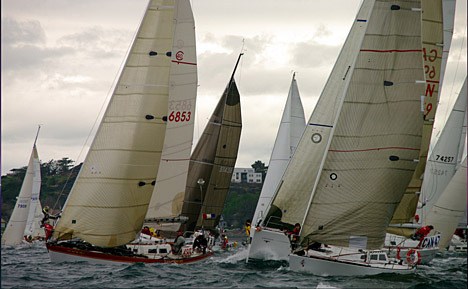Local sailor Norris Palmer became an international champion in the Swiftsure Race Series on 29 May when he and his wife, Karen, sailed Fragile Habitat to a first place in the “S” division.
Lynn Adkins in Tinette also raced, but had to retire when his mainsail blew out during the start.
Norris sent me the following account of the race:
“This is the sailing event of the Pacific Northwest. Racers from every nook and cranny show up to take part in this perfectly run regatta. It can be an on-the-water experience like climbing Mount Everest, taking every bit of desire and stamina from you and your crew, or one of the easiest float ‘alongs’ that also can drive you crazy from constant tacking and headache concentration.
“This year it became both. The winds at the start began building to 35 gusting to 50 in some places. There were masts being broken and sails being ripped, along with an MOB.
“That night on the way out of the Strait of Juan de Fuca, the winds stopped and by morning, many had not even hit the halfway mark, actually going backwards after all that struggle to get there.
“Over 50 boats withdrew; these weren’t weekend sailors, they were constant on the circuit, hard-hitting sailors that got taken to their human ends. It’s a war out there battling the currents in the straits, and these are not giant boats but 20- to 60-footers. I haven’t seen that many people on a group of 20-footers in my life. They don’t get to sit down in the hatch and sleep either. It’s really grueling to the racers.
“Now, Karen and I and the pups raced and finished up in the top of our group, but they have made several courses and ours was the short one to Pedder Bay. It was only 45 miles and 8 hours with swells like I and the dogs have never seen. I assure you that no matter how large your boat is, the wind and waves can throw it anyway it wants. The wind was so strong and the waves were such that in the event of a tack, by the time you were under propulsion you were broadside to the oncoming 6-foot swells which then took your boat and slammed it into Mother Ocean. We had every book and chart and anything else that was not nailed down ending up on the deck.
“The start is probably the most challenging — challenging in that you have to find a place to hide in the 200-plus boats tacking and jibing and trying to get a position in their start while waiting for your start. I found that hiding on starboard with your motor running up on the start pin is the safest as no one would be there if they were starting … It was so cool to be part of the action and that is really one way to learn your skills. It’s like trying to cross the freeway during rush hour.
“I have never been in seas like this that I can remember. It’s a really hard course in that you have to know the currents. It is so changing.
From our sailing club, Lynn Adkins with Tinette showed up with their J124 41-foot racer. What a great start, but halfway out of the line you could see a small flapping of sail on the leech and then R-I-P-P-P. Their main blew out from the wind and they had to retire. Larry and Jayne Hemmerich, with their jet ski on steroids, ‘Knotty Dog,’ a Protector 28-foot, were there powering through the start line taking pictures as well.
“Fragile Habitat got in late and it was time to go to dinner at some of the best restaurants in Victoria and enjoy the lights of the harbor and sounds of the street entertainers. I love Victoria and it is the best destination right in our backyard. We met sailors coming in from the long run around Swiftsure Bank out at the opening of Juan de Fuca and it became party time.
“It is such a great time when people of all incomes and ages get together to become one — a sailor, all experiencing that climb up the sea with only a hull to save your life.”
— Fred Hoeppner is a retired Navy captain and a competitive sailor living on San Juan Island.




